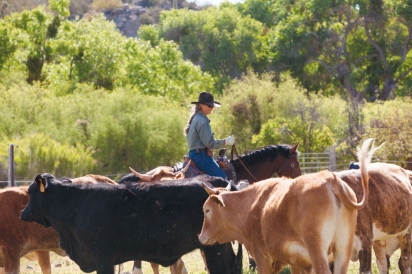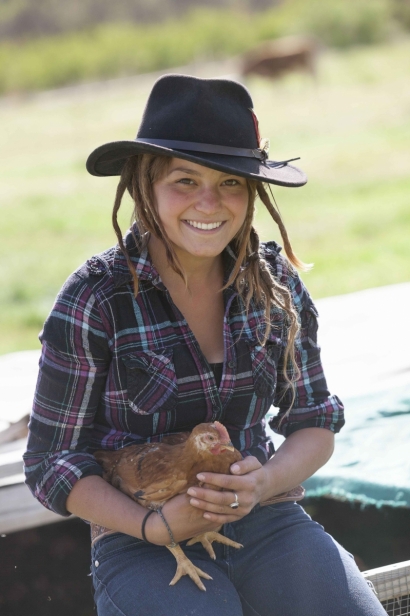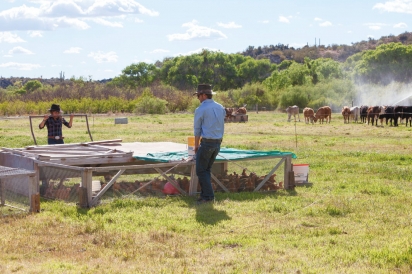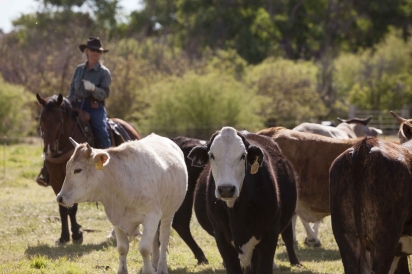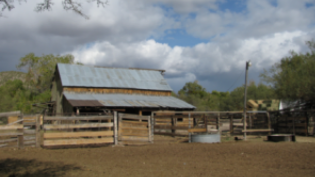Nature's Circles of Life
CELEBRATING 50 YEARS OF HOLISTIC MANAGEMENT AT DATE CREEK RANCH
A half century ago, Phillip and Geri Knight bought this ranch north of Wickenburg, building on family traditions of Arizona ranching stretching back to the 1870s. Today Date Creek Ranch has evolved to be a very different place than it was in 1966. Throughout, a commitment to wise, even sacrificial, decisions to operate in harmony with the environment has guided three generations.
The senior Knights eventually passed the ranch management along to their daughter Kimberley Knight and her husband, Stefan Wolf. Stefan came to Date Creek from half a world away, having moved to Arizona from Germany. He had such a passion for the American West that he made regular trips to Arizona, eventually meeting Kimberley at Date Creek and marrying her, becoming partners in life and on the ranch.
Now Ryan, Kimberley’s son, has become the fifth generation in this family to make his living from Arizona land and the third generation to ranch at Date Creek, adding pastured poultry and lamb to the ranch’s offerings.
Back in 1966, the Date Creek was like many Arizona creeks: mainly sand and gravel with sparse vegetation marking its course. Kimberley is proud to note that under her father’s novel method of resting pastures during the growing season, Phillip Knight brought the creek back to life in just 15 years, winning several environmental awards. The creek is now lined with willows and cottonwoods, reeds, rushes and cattails. The thick vegetation has created an ideal home for reintroduced beaver, turkeys, and other wildlife.
Kimberley and Stefan have built on and expanded Phillip’s sustainable approach. The ranch is now a demonstration site of Holistic Management, an intensive method of solving management problems by a deep analysis of what is good for all life on the ranch, including the wildlife, the people and the community.
Under their direction, cattle and horses, pastured hogs and chickens are treated with respect. “We want to see each animal be allowed to be the animal they were meant to be, for chickens to express their ‘chickenness,’” Kimberley explains.
The ranch had grass-fed and grass-finished cattle long before grass-fed became a buzzword. The 38,000 acres of Date Creek Ranch (including that leased from State Trust Land) is divided into 52 pastures. Unlike most ranches, each pasture here is used for only short periods at a time. With this schedule of rotating the cattle, the pastures get plenty of rest, which keeps each one healthier. Like her father, Kimberley ensures special care is given to resting creek-adjacent pastures, protecting the riparian area.
Riding twice a week to check on their condition, she knows these 38,000 acres so well that in each pasture covering hundreds of acres she knows exactly where the cows like to rest at midday, chewing their cud. Her favorite ride though is to the Badlands section of the ranch, appreciated for its isolation and rugged desert beauty.
The cows give birth on the range, the Angus-Brahma and Hereford-Brahma cross breeds specially chosen as “they are good protectors of their babies, are go-getters, they can make the rough climb to the top of a mountain,” Kimberley says.
Roundup is done three or four times a year, at which point they wean any calves that are about 8 months old. The industry practice is to forcefully separate moms and calves. This is intensely stressful for both, with calves bawling and moms futilely calling for them. Here, weaning is done with a “blab” temporarily put around the calf’s muzzle, which precludes nursing but allows grazing. At Date Creek, calves stay with their mothers, often forming longstanding family groups in a natural herd.
A change in the way the ranchers work with the animals is another step in the evolution of the ranch. As Kimberley explains, “Cows are prey animals. We do our best to not act like predators, creating fear. When handling them, we want our idea to become their idea.” This is true with both horses and cattle, as wise understanding and gentle use of their natural instincts is used instead of force. For instance, a routine task is getting cattle to go through a gate. By advancing slowly into and retreating from a cow’s “flight zone,” they let the cow see the gate as an opening that it chooses to move through.
Another illustration of the Holistic Management practice is the choice to pasture poultry in large mobile pens rather than what some call “free range.” Too often, this term means chickens are kept in large dusty pens, where they often live in their own manure, or have only very limited access to the outdoors. Though more labor intensive, as Ryan moves the pens by hand every single day, the pastured chickens enjoy fresh air, sunshine, scratching for bugs and, most importantly, fresh clean grass. The breed, Poulet Rouge originally from France, was specifically chosen for its hardiness, deep rich flavor and increased healthy omega-3 fats.
The ranch is fully solar powered. Thanks to Arizona’s abundant sunshine, water is pumped to the various pastures. One water line is 18 miles long! And if a pump breaks down or the inverter fails, it’s up to the family’s skill and instincts to fix what needs fixing. This is a quality Kimberley says was instilled in her by her father since childhood. If she was sent to do a task and an obstacle presented itself, she was expected to figure it out... and usually did!
Because their cattle are both grass-fed and (what sets them apart from conventional beef production) grass-finished, their methods make the ranch a carbon sink rather than a contributor to climate change. For climate advocates this is good news, the notion that eating beef fully raised without feedlot corn can actually pull carbon out of the air and store it in the soil.
Both creek and desert are improved by the presence of cattle. Their hooves break up and loosen the soil, their urine and manure moisten and feed it, essentially preparing a fertile seedbed for the desert plants to grow. Dead desert plants are trampled by cattle, returning the minerals to the soil for new plants to use. The diversity of plants feed the cattle which feed the human customers, bringing a rich portfolio of micronutrients. The cattle thereby benefit the desert plants, which benefit the cattle.
September is harvest time in the apple orchard originally planted by Kimberley’s father. Driving to the ranch for apple picking, at mile marker 177.5 on Highway 93, one comes upon the sign for Date Creek Ranch, marking the gravel road turnoff. Just as the first-time visitor may start to wonder if there’s been a wrong turn, another sign appears on the side of the road: Yes, there really is an orchard in the middle of this desert! A few more turns and the road descends into the canyon. At the bottom lies Date Creek, which makes the ranch’s green pastures and abundant orchard possible.
The orchard is organic, and has natural growth between the rows which protects the pollinators, which help turn blossoms into apples.
For many pick-your-own apple customers the road trip to the orchard is part of the fun. For all of them, it’s not just about apple picking. It’s watching the children run free, while they learn where food really comes from. It’s a lazy-day picnic at the wooden tables under the ancient mesquite tree. It’s weighing the literal fruits of one’s labor on the rustic scale and deciding yes, it’s worth one more trip through the orchard for another box. It’s feeding one of those apples to a gentle horse recently retired from working the cattle. It’s enjoying the birdsong as the musical backdrop to the day, punctuated by the occasional crowing of a rooster. It’s feeling like part of the Date Creek community of customers.
This community has a variety of reasons for wanting to be a part of the Date Creek story. For some, it’s knowing the animals had the life they were meant to, with humane handling at every step along the way. For others, it’s more bang for the buck, a healthy profile of nutrientdense meals, with higher omega-3s, phytonutrients from the diversity of forage and the savings of buying in bulk. Many love the idea of supporting a local historic ranch, getting to actually meet “their” ranchers in person at delivery, and hearing more about the ranch-to-table story.
From father to daughter to son, the values of care for the soil and of care for those fed by the soil endure. In the orchard the hogs feed on fallen apples, helping to protect the trees from disease and insects, while at the same time fertilizing them. The hogs thereby benefit the orchard which benefits the hogs. The ranchers use natural horsemanship principles which help the horses better help them in working cattle. The chickens follow the cattle in the irrigated pastures, spreading the manure of both cow and chicken, fertilizing and refreshing the grasses, which then feed both cow and chicken. Wildlife, even including predators like bobcat and mountain lions, are valued for their contributions to the ecosystem as a whole.
As Kimberley puts it, “We have an unwritten contract with the animals. We take care of them and at the end of their lives they take care of us.” And so go the circles of life at the ranch on Date Creek.
Date Creek Ranch
For more information about Date Creek, its history, how to order meat for delivery to north Phoenix, direction to the ranch, updates on fruit picking, and much more, see datecreekranch.com



